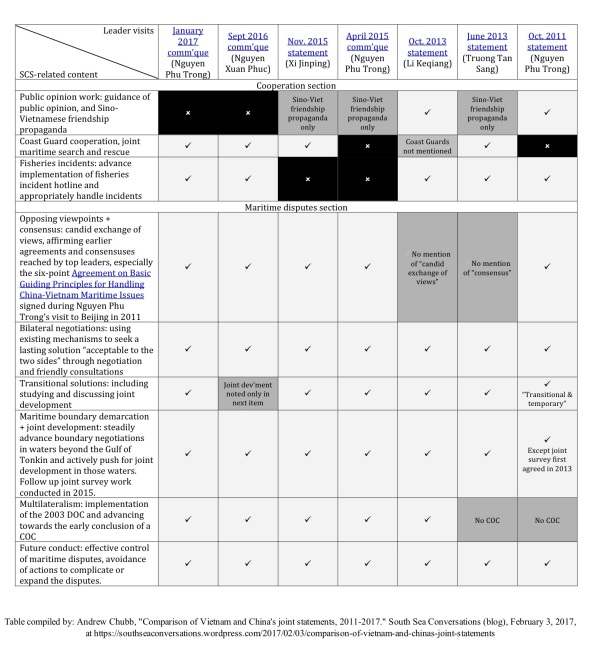Comparison of Vietnam and China’s joint statements, 2011-2017
Posted: February 3, 2017 Filed under: China-Vietnam, Ministry of Foreign Affairs, South China Sea | Tags: arbitration, China-Vietnam, China-Vietnam joint statement, China-Vietnam relations, joint communique, Nguyen Phu Trong, nine dashed line, nine-dash line, Philippines vs China arbitration, Sino-Vietnamese relations, south china sea, South China Sea arbitration, UNCLOS, UNCLOS and South China Sea, Vietnam-China joint statement 2 Comments
Comparison of Sino-Vietnamese joint statements since 2011 (click to enlarge). Links to sources: January 2017 communique (Nguyen Phu Trong visit to China); Sept 2016 communique (Nguyen Xuan Phuc visit to China); Nov. 2015 statement (Xi Jinping visit to Vietnam); April 2015 communique (Nguyen Phu Trong visit to China); Oct. 2013 statement (Li Keqiang visit to Vietnam); June 2013 statement (Truong Tan Sang visit to China); Oct. 2011 statement (Nguyen Phu Trong visit to China).
East Asia Forum has kindly published a piece from me on recent developments in Sino-Vietnamese relations. To supplement it, i’m posting here a table comparing the South China Sea-related elements of the last 7 joint statements between the two.
The comparative table was the basis for the article’s argument that General Secretary Nguyen Phu Trong’s visit to Beijing last month did not involve any softening of Vietnam’s position on the issue.
According to a knowledgeable Vietnamese source, there are three types of Sino-Vietnamese bilateral joint statements issued after high-level meetings. In ascending order of importance these are:
- Joint press release (联合新闻公报, thông cáo báo chí)
- Joint communique (联合公报, thông cáo chung)
- Joint statement (联合声明, tuyên bố chung)
These documents are often not released in English, and some of the translations that have appeared have been incomplete or unreliable, so the table above compares the Chinese full text as published by state media (links are in the caption area above).
The table also includes an item, not discussed in the EAF article for space reasons, on cooperation in public opinion work. In the 2011 joint statement, the two sides pledged cooperation on “strengthening public opinion guidance and management” – which, in the context of several weeks of anti-China protests through the middle of that year, was tantamount to a Vietnamese undertaking to dampen anti-China sentiments.
Interestingly, however, there has been no analogous item in the recent joint documents — even after another, even more intense, wave of anti-China sentiments burst forth in 2014 during the HYSY-981 oil rig standoff. Its omission from subsequent documents might indicate an acceptance on China’s behalf of the strength Vietnamese nationalist sentiments that flow in its direction at times of heightened tensions. Perhaps also an acknowledgement that Hanoi is already doing what it can to promote Sino-Vietnamese friendship? Any other readings?
The EAF piece is reposted below. Based on some early feedback, i should have been clearer that in suggesting . . .
China may have pulled back from its pursuit of particular claims that have no basis in international law
. . . i do not mean the PRC has seen the light and is abandoning all claims deemed unlawful in the UNCLOS arbitration. Just that there are some unlawful aspects of China’s claims that it is no longer pushing, and this has removed some of the major drivers of Sino-Vietnamese tensions.
As always, further comments, arguments, additions and corrections are much appreciated.
